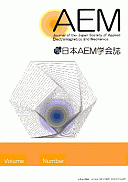Volume 25, Issue 1
Displaying 1-9 of 9 articles from this issue
- |<
- <
- 1
- >
- >|
Special Topic: Robots and Its Related Technologies
-
2017Volume 25Issue 1 Pages 1
Published: 2017
Released on J-STAGE: May 24, 2017
Download PDF (720K) -
2017Volume 25Issue 1 Pages 2-8
Published: 2017
Released on J-STAGE: May 24, 2017
Download PDF (1513K) -
2017Volume 25Issue 1 Pages 9-16
Published: 2017
Released on J-STAGE: May 24, 2017
Download PDF (1905K) -
2017Volume 25Issue 1 Pages 17-23
Published: 2017
Released on J-STAGE: May 24, 2017
Download PDF (3562K) -
2017Volume 25Issue 1 Pages 24-27
Published: 2017
Released on J-STAGE: May 24, 2017
Download PDF (2156K) -
2017Volume 25Issue 1 Pages 28-35
Published: 2017
Released on J-STAGE: May 24, 2017
Download PDF (2038K)
Regular Papers
-
2017Volume 25Issue 1 Pages 36-41
Published: 2017
Released on J-STAGE: May 24, 2017
Download PDF (9959K) -
2017Volume 25Issue 1 Pages 42-48
Published: 2017
Released on J-STAGE: May 24, 2017
Download PDF (1145K) -
2017Volume 25Issue 1 Pages 49-54
Published: 2017
Released on J-STAGE: May 24, 2017
Download PDF (1214K)
- |<
- <
- 1
- >
- >|
